2014 HONDA RIDGELINE airbag
[x] Cancel search: airbagPage 15 of 422
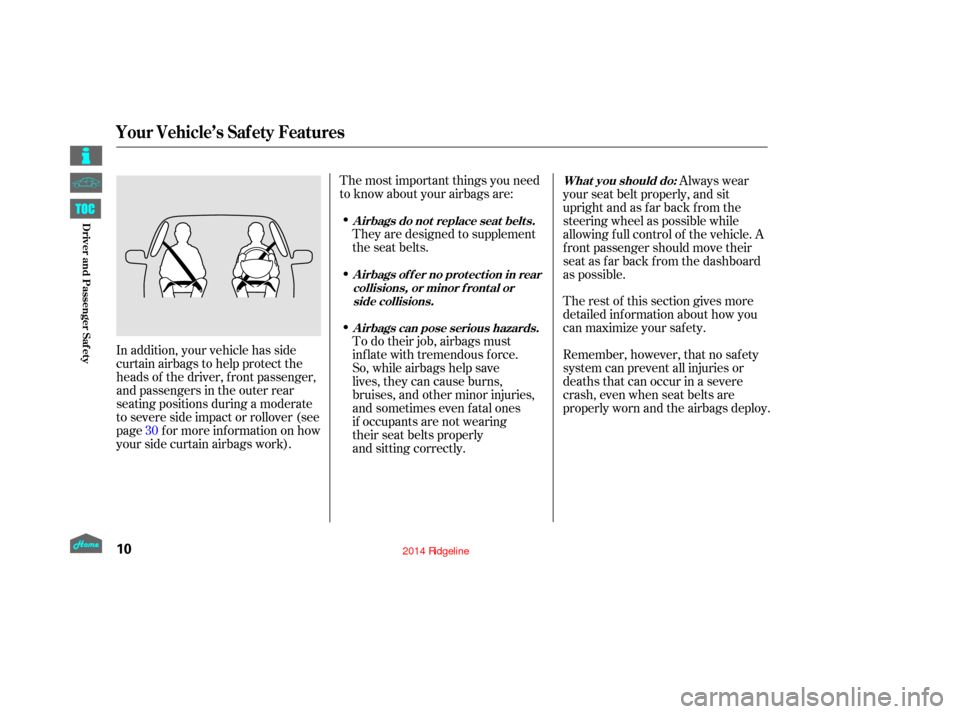
The rest of this section gives more
detailed inf ormation about how you
can maximize your saf ety.
The most important things you need
to know about your airbags are:
They are designed to supplement
the seat belts.
Remember, however, that no saf ety
system can prevent all injuries or
deaths that can occur in a severe
crash, even when seat belts are
properly worn and the airbags deploy.Always wear
your seat belt properly, and sit
upright and as f ar back f rom the
steering wheel as possible while
allowing f ull control of the vehicle. A
f ront passenger should move their
seat as far back from the dashboard
as possible.
To do their job, airbags must
inflate with tremendous force.
So, while airbags help save
lives, they can cause burns,
bruises, and other minor injuries,
and sometimes even fatal ones
if occupants are not wearing
their seat belts properly
and sitting correctly.
In addition, your vehicle has side
curtain airbags to help protect the
heads of the driver, f ront passenger,
and passengers in the outer rear
seating positions during a moderate
to severe side impact or rollover (see
page f or more inf ormation on how
your side curtain airbags work).
30
Your Vehicle’s Saf ety Features
Airbags do not replace seat belts. What you should do:
Airbags can pose serious hazards.
Airbags of f er no protection in rear
collisions, or minor f rontal or side collisions.
10
12/08/09 16:00:25 31SJC670_017
Driver and Passenger Saf ety
Page 19 of 422
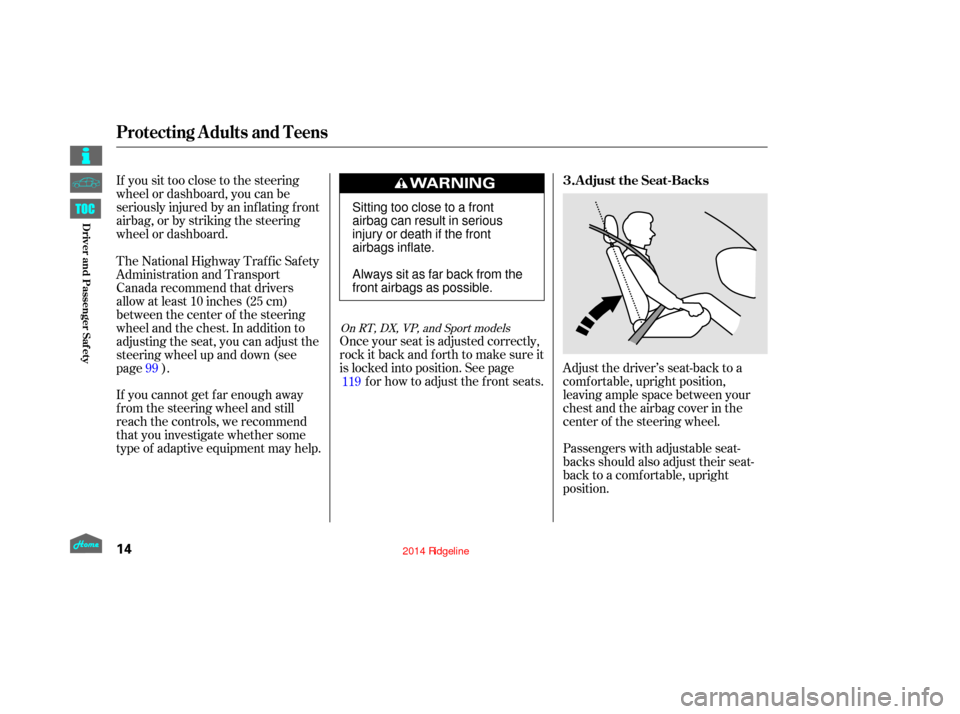
If you sit too close to the steering
wheel or dashboard, you can be
seriously injured by an inf lating f ront
airbag, or by striking the steering
wheel or dashboard.Adjust the driver’s seat-back to a
comf ortable, upright position,
leaving ample space between your
chest and the airbag cover in the
center of the steering wheel.
Passengers with adjustable seat-
backs should also adjust their seat-
back to a comf ortable, upright
position.
Once your seat is adjusted correctly,
rock it back and f orth to make sure it
is locked into position. See page
f or how to adjust the f ront seats.
If you cannot get f ar enough away
f rom the steering wheel and still
reach the controls, we recommend
that you investigate whether some
type of adaptive equipment may help. The National Highway Traffic Safety
Administration and Transport
Canada recommend that drivers
allow at least 10 inches (25 cm)
between the center of the steering
wheel and the chest. In addition to
adjusting the seat, you can adjust the
steering wheel up and down (see
page ). 99
119
On RT, DX, VP, and Sport models
Protecting A dults and Teens
Adjust the Seat-Backs
3.
14
Sitting too close to a front
airbag can result in serious
injury or death if the front
airbags inflate.
Always sit as far back from the
front airbags as possible.
12/08/09 16:00:54 31SJC670_021
Driver and Passenger Saf ety
Page 23 of 422
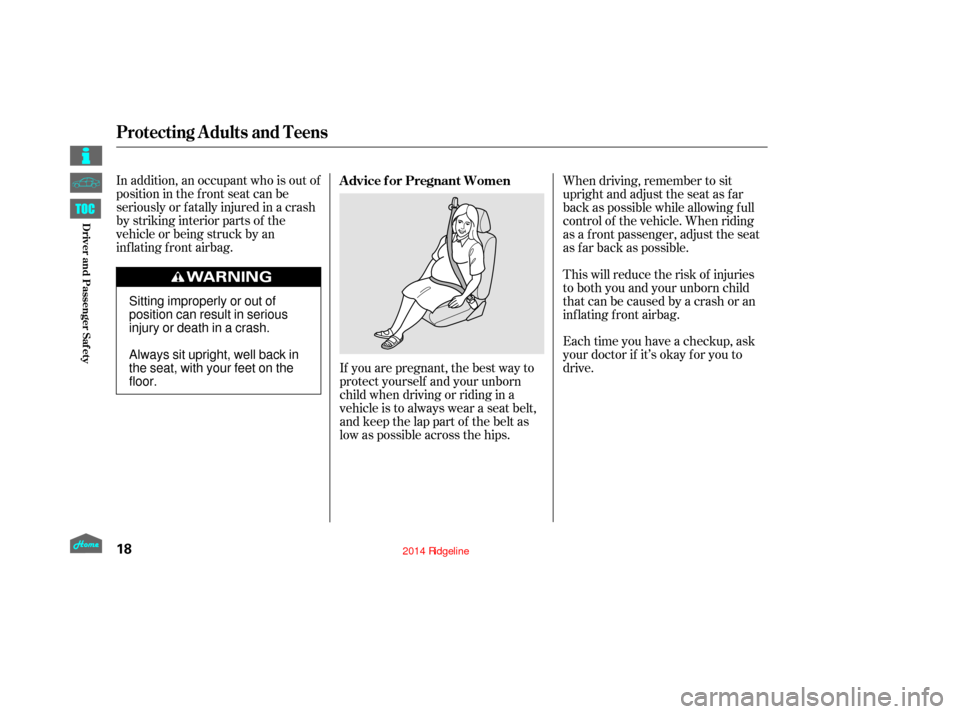
In addition, an occupant who is out of
position in the f ront seat can be
seriously or f atally injured in a crash
by striking interior parts of the
vehicle or being struck by an
inflating front airbag.If you are pregnant, the best way to
protect yourself and your unborn
child when driving or riding in a
vehicle is to always wear a seat belt,
and keep the lap part of the belt as
low as possible across the hips.When driving, remember to sit
upright and adjust the seat as f ar
back as possible while allowing f ull
control of the vehicle. When riding
as a f ront passenger, adjust the seat
as far back as possible.
This will reduce the risk of injuries
to both you and your unborn child
that can be caused by a crash or an
inflating front airbag.
Each time you have a checkup, ask
your doctor if it’s okay f or you to
drive.
Advice f or Pregnant Women
Protecting A dults and Teens
18
Sitting improperly or out of
position can result in serious
injury or death in a crash.
Always sit upright, well back in
the seat, with your feet on the
floor.
12/08/09 16:01:23 31SJC670_025
Driver and Passenger Saf ety
Page 24 of 422
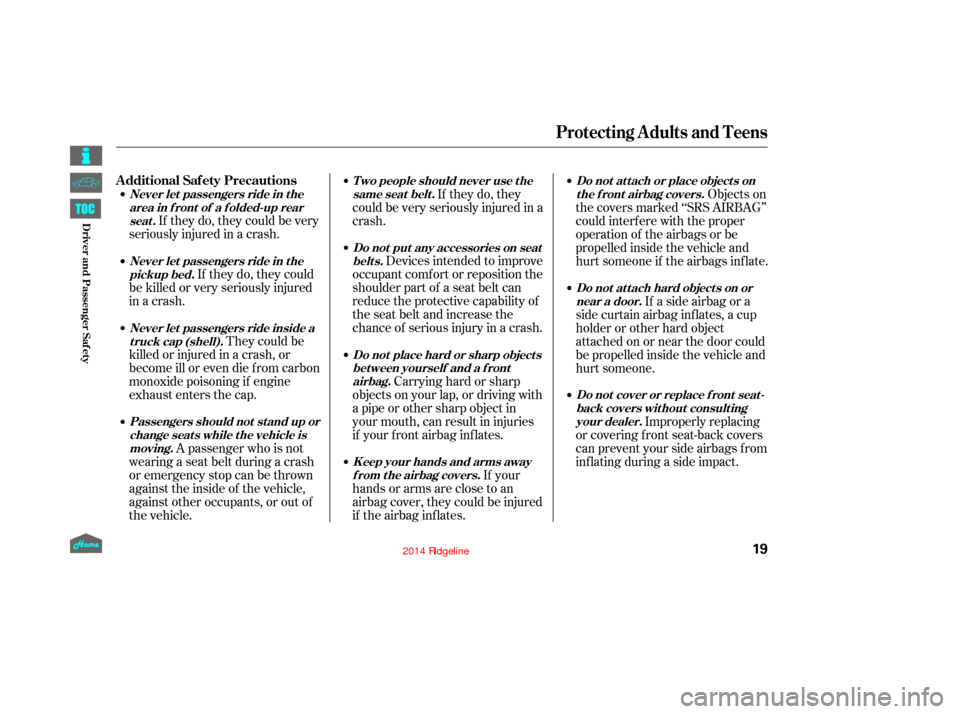
If they do, they could be very
seriously injured in a crash.
If they do, they could
be killed or very seriously injured
in a crash.
They could be
killed or injured in a crash, or
become ill or even die f rom carbon
monoxide poisoning if engine
exhaust enters the cap.
A passenger who is not
wearing a seat belt during a crash
or emergency stop can be thrown
against the inside of the vehicle,
against other occupants, or out of
the vehicle. If they do, they
could be very seriously injured in a
crash.
Devices intended to improve
occupant comf ort or reposition the
shoulder part of a seat belt can
reduce the protective capability of
the seat belt and increase the
chance of serious injury in a crash.
Carrying hard or sharp
objects on your lap, or driving with
a pipe or other sharp object in
your mouth, can result in injuries
if your f ront airbag inf lates.
If your
hands or arms are close to an
airbag cover, they could be injured
if the airbag inf lates. Objects on
the covers marked ‘‘SRS AIRBAG’’
could interf ere with the proper
operation of the airbags or be
propelled inside the vehicle and
hurt someone if the airbags inf late.
If a side airbag or a
side curtain airbag inf lates, a cup
holder or other hard object
attached on or near the door could
be propelled inside the vehicle and
hurt someone.
Improperly replacing
or covering f ront seat-back covers
can prevent your side airbags f rom
inf lating during a side impact.
Protecting A dults and Teens
Additional Saf ety Precautions
Never let passengers ride in t he
area in front of a folded-up rearseat .
Never let passengers ride in t hepickup bed.
Never let passengers ride inside atruck cap (shell).
Passengers should not stand up orchange seats while the vehicle ismoving. T wo people should never use t he
same seat belt .
Do not put any accessories on seatbelts.
Do not place hard or sharp object sbet ween yourself and a f rontairbag.
K eep your hands and arms awayf rom t he airbag covers. Do not at t ach or place object s on
the f ront airbag covers.
Do not at t ach hard object s on ornear a door.
Do not cover or replace f ront seat -back covers wit hout consult ingyour dealer.
19
12/08/09 16:01:32 31SJC670_026
Driver and Passenger Saf ety
Page 27 of 422
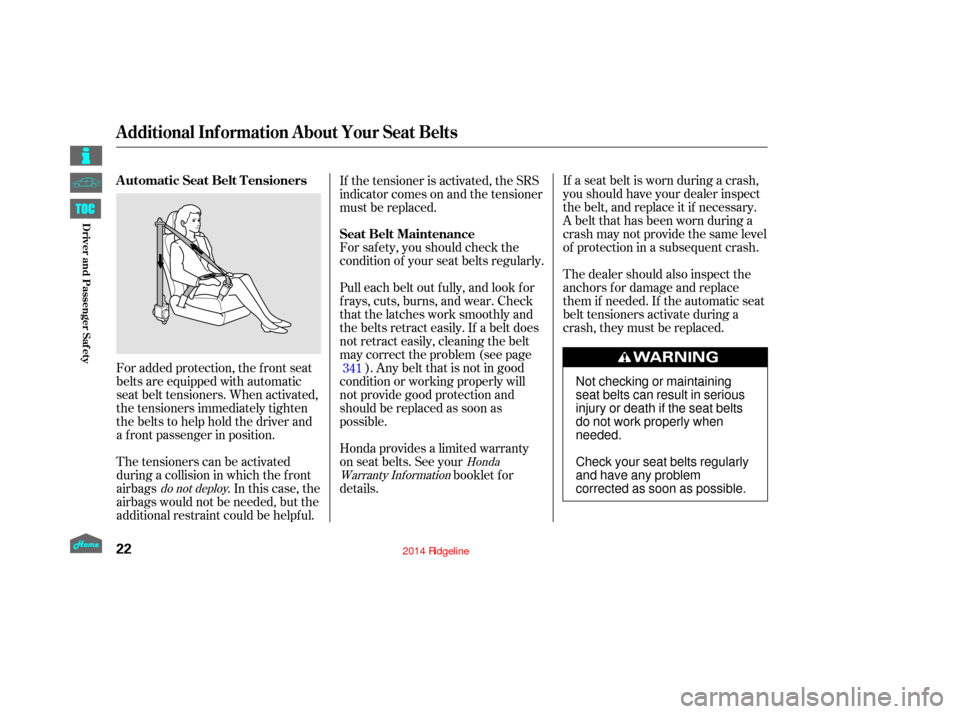
If a seat belt is worn during a crash,
you should have your dealer inspect
the belt, and replace it if necessary.
A belt that has been worn during a
crash may not provide the same level
of protection in a subsequent crash.
The dealer should also inspect the
anchors f or damage and replace
them if needed. If the automatic seat
belt tensioners activate during a
crash, they must be replaced.
If the tensioner is activated, the SRS
indicator comes on and the tensioner
must be replaced.
For saf ety, you should check the
condition of your seat belts regularly.
Pull each belt out f ully, and look f or
f rays, cuts, burns, and wear. Check
that the latches work smoothly and
the belts retract easily. If a belt does
not retract easily, cleaning the belt
may correct the problem (see page
). Any belt that is not in good
condition or working properly will
not provide good protection and
should be replaced as soon as
possible.
Honda provides a limited warranty
on seat belts. See your booklet f or
details.
For added protection, the f ront seat
belts are equipped with automatic
seat belt tensioners. When activated,
the tensioners immediately tighten
the belts to help hold the driver and
a f ront passenger in position.
The tensioners can be activated
during a collision in which the f ront
airbags
. In this case, the
airbags would not be needed, but the
additional restraint could be helpf ul. 341
Honda
Warranty Inf ormation
do not deploy
Additional Inf ormation About Your Seat Belts
Seat Belt Maintenance
A utomatic Seat Belt T ensioners
22
Not checking or maintaining
seat belts can result in serious
injury or death if the seat belts
do not work properly when
needed.
Check your seat belts regularly
and have any problem
corrected as soon as possible.
12/08/09 16:01:57 31SJC670_029
Driver and Passenger Saf ety
Page 28 of 422

CONT INUED
A irbag System Components
Additional Inf ormation About Your Airbags
23
(1)(3)
(5)
(4) (5)
(6)
(10)
(13)
(9) (8) (2)
(16)(4)
(15)
(16)
(8)
(14) (7)(12)
(14)
(11)
(1) Driver’s Front Airbag
(2) Passenger’s Front Airbag
(3) Control Unit
(4) Front Seat Belt Tensioners
(5) Side Airbags
(6) Driver’s Seat Position Sensor
(7) Front Passenger’s Weight Sensors
(12) Front Passenger’s Weight Sensors Control Unit/
OPDS Sensors Control Unit
(13) SRS Indicator
(14) Side Curtain Airbags
(15) Roll Rate Sensor
(16) Side Impact Sensors (Second) (8) Front Impact Sensors
(9) Passenger Airbag Off Indicator
(10) Side Impact Sensors (First)
(11) Occupant Position Detection System (OPDS) Sensors
12/08/09 16:02:03 31SJC670_030
Driver and Passenger Saf ety
Page 29 of 422

Weight sensors that monitor the
weight on the f ront passenger’s
seat. If the weight is about 65 lbs
(29 kg) or less (the weight of an
inf ant or small child), the
passenger’s f ront airbag will be
turned of f (see page ).
A rollover sensor that can detect if
your vehicle is about to roll over
and signal the control unit to
deploy both side curtain airbags
(see page ).
A sophisticated electronic system
that continually monitors and
records inf ormation about the
sensors, the control unit, the
airbag activators, the seat belt
tensioners, and driver and f ront
passenger seat belt use when the
ignition switch is in the ON (II)
position.
Automatic front seat belt
tensioners (see page ).
Sensors that can detect a
moderate to severe front impact,
side impact, or if your vehicle is
about to rollover.
Sensors that can detect whether a
child is in the passenger’s side
airbag path and signal the control
unit to turn the airbag of f (see
page ).
Sensors that can detect whether
the driver’s seat belt and the f ront
passenger’s seat belt are latched
or unlatched (see page ).
A driver’s seat position sensor that
monitors the distance of the seat
from the front airbag. If the seat is
too f ar f orward, the airbag will
inf late with less f orce (see page
).
Your airbag system includes:
Two SRS (supplemental restraint
system) f ront airbags. The driver’s
airbag is stored in the center of
the steering wheel; the f ront
passenger’sairbagisstoredinthe
dashboard. Both are marked ‘‘SRS
AIRBAG’’ (see page ).
Two side airbags, one f or the
driver and one f or a f ront
passenger. The airbags are stored
in the outer edges of the seat-
backs. Both are marked ‘‘SIDE
AIRBAG’’ (see page ).
Two side curtain airbags, one f or
each side of the vehicle. The
airbags are stored in the ceiling,
above the side windows. The f ront
and rear pillars are marked ‘‘SIDE
CURTAIN AIRBAG’’ (see page ). 27
30
27 20
29
25
28
30 22
Additional Inf ormation About Your Airbags
24
12/08/09 16:02:13 31SJC670_031
Driver and Passenger Saf ety
Page 30 of 422

CONT INUED
During a frontal crash, your seat belt
restrains your lower body and torso,
and the f ront airbag helps protect
your head and chest.
Although both airbags normally
inf late within a split second of each
other, it is possible f or only one
airbag to deploy.
This can happen if the severity of a
collision is at the margin, or
threshold, that determines whether
or not the airbags will deploy. In
such cases, the seat belt will provide
suf f icient protection, and the
supplemental protection of f ered by
the airbag would be minimal.
Only the driver’s airbag can deploy if
there is no passenger in the f ront
seat, or if the advanced airbag
system has turned the passenger’s
airbag off (see page ).
If the rate of deceleration is high
enough, the control unit will inf late
the driver’s and f ront passenger’s
airbags, at the time and with the
f orce needed. If you ever have a moderate to
severe f rontal collision, sensors will
detect the vehicle’s rapid
deceleration.
An indicator on the instrument
panel that alerts you to a possible
problem with your airbag system
components (see page ).
An indicator on the instrument
panel that alerts you that the
passenger’s side airbag has been
turned of f (see page ).
An indicator on the dashboard that
alerts you that the passenger’s
f ront airbag has been turned of f
(see page ).
Emergency backup power in case
your vehicle’s electrical system is
disconnected in a crash.
27
30
31
31
Additional Inf ormation About Your Airbags
How Your Front A irbags Work
25
12/08/09 16:02:23 31SJC670_032
Driver and Passenger Saf ety